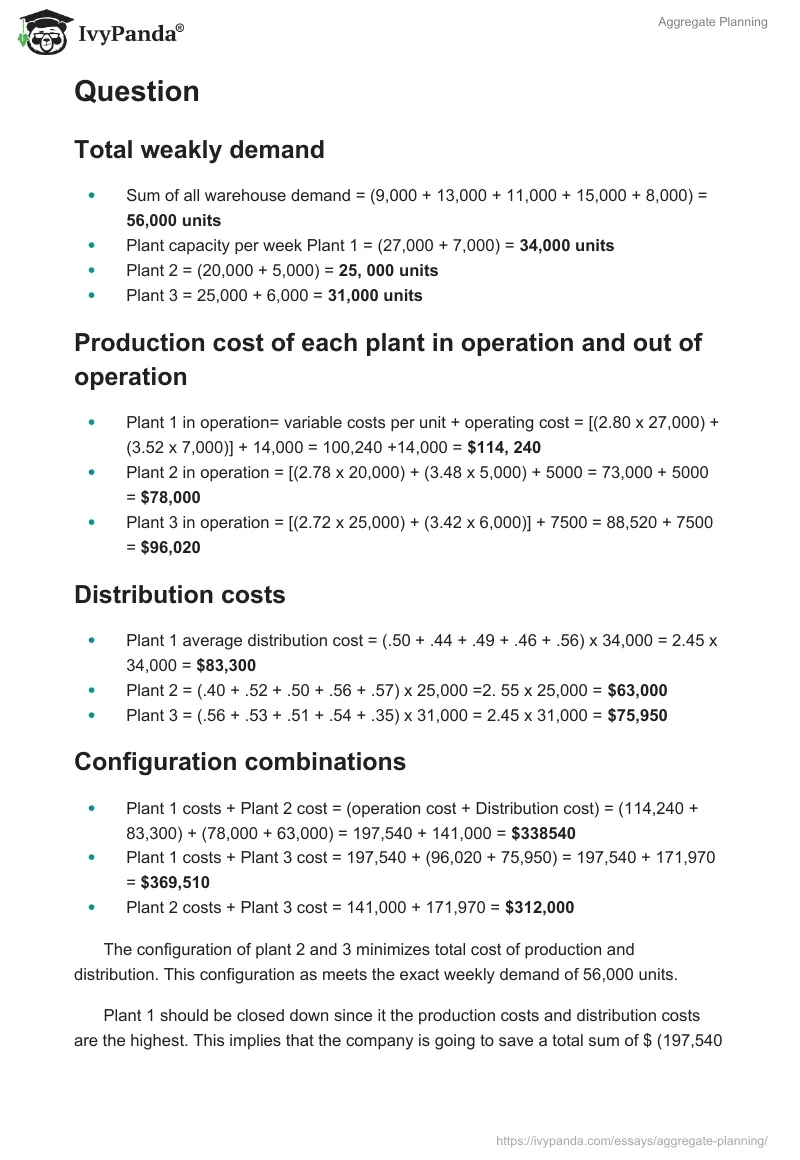Aggregate planning is a very critical tool for both manufacturing and services companies. It is concerned with determining the quantity and timing of production in order to meet forecasted demand at the lowest cost possible and by maintaining the quality of the product at the same time. Aggregate planning is the functional role of operational managers. It involves making scheduling decisions that address issues of matching production to meet changes in demand (Heizer and Render, p. 512).
Aggregate planning entails controlling of inventories, production rates, number of workers, production capacity, and other production variables. The elements are achieved through various strategy options that classified as either capacity options or demand options (Heizer and Render, p. 514).
There are various capacity option strategies that operation managers in manufacturing and some services firms can utilize in aggregate planning to meet demand forecasts in future. Changing inventory level strategy is a capacity option where the manager makes adjustments in the level of inventory in order to meet future demand. Some operations managers can match firm production rate requirements. The other strategy is varying of production rates through overtime or idle time.
Firms operations department may also use subcontracting strategy option so as to acquire short term capacity requirements during peak demand periods (Heizer and Render, p. 515). The last capacity strategy that can be utilized by operations managers is the use of part-time workers.
Influencing demand is a demand strategy that firms try to increase demand for their product through advertising, personal selling, discounts, and promotions. Companies can also use “back ordering” during high demand periods (Heizer and Render, p. 516) as aggregate planning strategy. Finally, firms can also use counter-seasonal product and service mixing as one of the demand option (Heizer and Render, p. 517).
Operations managers utilize a number of aggregate planning techniques. The most popular technique is the graphical approach that is easy to understand it contains few variables. The other methods are mathematical approaches that tend to give optimal plans in minimizing cost and revenues (Heizer and Render, p. 524).
Question
Total weakly demand
- Sum of all warehouse demand = (9,000 + 13,000 + 11,000 + 15,000 + 8,000) = 56,000 units
- Plant capacity per week Plant 1 = (27,000 + 7,000) = 34,000 units
- Plant 2 = (20,000 + 5,000) = 25, 000 units
- Plant 3 = 25,000 + 6,000 = 31,000 units
Production cost of each plant in operation and out of operation
- Plant 1 in operation= variable costs per unit + operating cost = [(2.80 x 27,000) + (3.52 x 7,000)] + 14,000 = 100,240 +14,000 = $114, 240
- Plant 2 in operation = [(2.78 x 20,000) + (3.48 x 5,000) + 5000 = 73,000 + 5000 = $78,000
- Plant 3 in operation = [(2.72 x 25,000) + (3.42 x 6,000)] + 7500 = 88,520 + 7500 = $96,020
Distribution costs
- Plant 1 average distribution cost = (.50 + .44 + .49 + .46 + .56) x 34,000 = 2.45 x 34,000 = $83,300
- Plant 2 = (.40 + .52 + .50 + .56 + .57) x 25,000 =2. 55 x 25,000 = $63,000
- Plant 3 = (.56 + .53 + .51 + .54 + .35) x 31,000 = 2.45 x 31,000 = $75,950
Configuration combinations
- Plant 1 costs + Plant 2 cost = (operation cost + Distribution cost) = (114,240 + 83,300) + (78,000 + 63,000) = 197,540 + 141,000 = $338540
- Plant 1 costs + Plant 3 cost = 197,540 + (96,020 + 75,950) = 197,540 + 171,970 = $369,510
- Plant 2 costs + Plant 3 cost = 141,000 + 171,970 = $312,000
The configuration of plant 2 and 3 minimizes total cost of production and distribution. This configuration as meets the exact weekly demand of 56,000 units.
Plant 1 should be closed down since it the production costs and distribution costs are the highest. This implies that the company is going to save a total sum of $ (197,540 – 6,000) = $191,000 at the same time meeting the forecasted weekly demand of 56,000 units.
Work Cited
Heizer, Jay H, and B. Render. Principles of Operations Management. Upper Saddle River, New Jersey: Pearson Prentice Hall, 2006. Print.


 3.50
3.50
